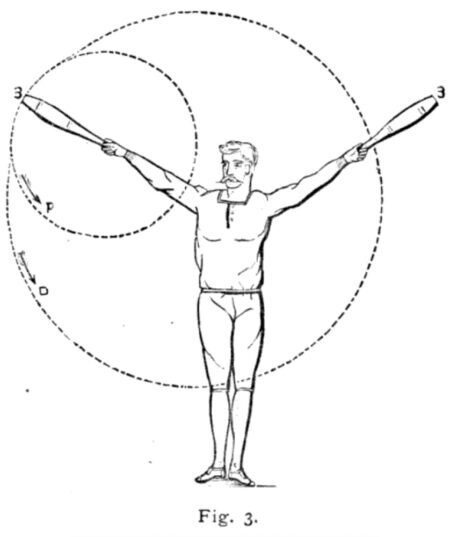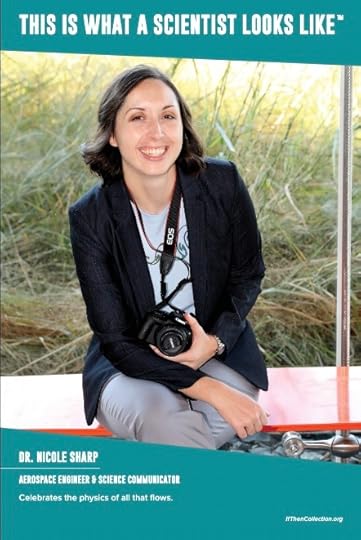Marc Abrahams's Blog, page 58
February 25, 2022
Ig Nobel Prizes on Jeopardy, again (with Limburger cheese)
Today the Ig Nobel Prizes made another appearance on the Jeopardy! TV game show, this time as an answer. It refers to the 2006 Ig Nobel Biology Prize, which concerned malaria mosquitoes, human feet, and Limburger cheese.
Note: The Jeopardy! wording refers to the cheese as being German, but Limburg, home of the fragrant cheese, is a bit to the west of Germany.
The Igs have been an entire category on Jeopardy at least eight times, in the past.
(Thanks to Martin Eiger for bringing this to our attention.)
Indian Club Swinging by an Amateur
Among the books about Indian club swinging by amateurs, Benjamin Gardiner’s 1884 book, Indian Club Swinging by an Amateur, is one of the most, in its way, swinging.
This illustration on page 14 of the book strikes some swingers as a highlight never to be completely forgotten:
February 24, 2022
Everything: What’s Missing Is What Gets Scientists Most Excited
What makes most scientists most excited is the same thing that—if they’ve heard about it—makes many non-scientists wonder if scientists are nuts: Way more than half of “the stuff the universe is made of” is still a mystery to scientists. Which may strike you as a crazy thing to realize, and a crazy thing to say. But there it is.
That’s the reality: Way more than half of what scientists KNOW exists is a complete mystery to them.
That’s the big physics mystery. There’s also a separate, equally big biology mystery. There are lots of other mysteries, but for the moment, let’s talk about those two.
PHYSICS: THE WHAT-IS-THE-UNIVERSE-MADE-OF MYSTERYWhat stuff is the universe made of? Scientists have painfully teased out a lot of the answer: atoms and electrons and quarks and all that stuff. But the physical stuff scientists know about—the atoms and electrons and quarks and gravity and electricity and all that stuff—is way less than half of all the stuff that make up the universe. Scientist have tons of evidence—megatons, and gigatons, and lots more than that—that makes it clear that most of the stuff in the universe is still a complete, staggering mystery to humans.
If you don’t hang around scientists, and are surprised at any of that, do a little googling on the phrases “mystery” and “dark matter” and “dark energy”.
BIOLOGY: THE HUMAN GENOME MYSTERYAlmost everyone has heard of “the human genome”. Most people know that the human genome, the thing that makes a person a person, rather than a whale or a worm or a palm tree—is made of a chemical, called DNA. DNA is very like an almost unfathomably looooooooong string of a very few kinds of beads. What has biologists so very, so increasingly excited is that most way more than way more than half of the DNA in a person is pretty damn mysterious. No one really understands what all that mysterious, way-more-than-half of all the DNA in a person does.
If you’d like a quick, gentle introduction to the more-than-half-of -the-human-genome-is-a-mystery mystery, read Nancy Shute’s “How machines help us decipher our genes” in the magazine Science News. Then, read the story Shute is introducing: Tina Hesman Saey’s “How the Human Genome Project revolutionized understanding of our DNA.”
IMPROBABLE RESEARCHThe mysterious stuff the universe is made of. The mysterious what-does-this-stuff-do most-of-the-human-genome. Scientists know these things are there. Are here.
And scientists know that nobody yet understands almost anything about these things. That’s why most research—most real research—is really and proudly (and gloriously) unpredictable. Whatever these mysterious things really are, whatever they really mean, it’s not what people expected.
Research is an attempt to understand things—the biggest parts of everything—that nobody has yet managed to understand. That’s why research—real research—is improbable research.
February 23, 2022
Popular Medicines as In-a-Pinch Radiation Sensors
If all hell breaks loose, so to speak, and you are fortunate to still be alive in a spot that is suddenly in a torrent of dangerous ionizing radiation, you can use any of several popular medicines to start to gauge the radiation level that you’re begin exposed to. That’s the theme of this new study:
“Popular Medicines as Radiation Sensors,” Anna Mrozik and Paweł Bilski, IEEE Sensors Journal, epub 2021. (Thanks to Ela Manikowska for bringing this to our attention.)
The authors, at the the Institute of Nuclear Physics Polish Academy of Sciences, explain:
During an uncontrolled release of radiation, it is highly unlikely that members of the public will be equipped with personal radiation dose monitors. In preparation for such a situation various personal objects are being investigated as emergency dosimeters. The already developed methods are not satisfactory, as they are time-consuming or require destruction of things valuable for victims. Here we show, that common pharmaceuticals, which frequently may be found e.g. in personal bags, are the perfect candidate as radiation sensors in emergencies. We investigated several over-the-counter medicines for occurrence of the optically stimulated luminescence phenomenon and found that all of them exhibit strong luminescence signal following exposure to ionizing radiation. Its intensity increases linearly with the absorbed dose. The highest sensitivity was shown by the popular painkillers based on ibuprofen and paracetamol…. Pharmaceuticals are also free of all disadvantages of other emergency dosimeters: their composition is standardized, sampling is immediate, the unit value is usually negligible.
These are the medicines that were tested, all of which “exhibited strong luminescence signal following exposure to ionizing radiation”:
Ibuprom
Ibuprom Max
Ibuprom Zatoki
Nurofen
Nurofen Forte
Paracetamol
Panadol
Panadol Extra
Aspirin
Polopiryna S
Scorbolamid
February 21, 2022
Handguns, Hot Sauce, Mousetraps and Testosterone [study]
If you were to give (male) students a Desert Eagle automatic handgun (replica) to handle* for a few minutes, would their testosterone levels rise? If so, would they be more inclined to dose a cup of water with FRANK’S® RedHot® sauce which they believed another (male) subject would have to drink?*
automatic handgun (replica) to handle* for a few minutes, would their testosterone levels rise? If so, would they be more inclined to dose a cup of water with FRANK’S® RedHot® sauce which they believed another (male) subject would have to drink?*
Such questions were asked – and subsequently answered in a study from Knox College, Illinois, US, entitled : Guns, Testosterone, and Aggression : An Experimental Test of a Mediational Hypothesis (A full copy of which may be found here )
* Notes.
[1] The control group were given a toy mousetrap to fondle instead – which did not appear to increase testosterone levels to any appreciable extent.
[2] No-one actually had to drink any hot sauce.
February 18, 2022
The Insect Fear Festival is Coming
The 2022 Insect Fear Festival is coming. Run! Jump! Fly! One way or another or another, get to it on Saturday, February 26, 2022!
The festival is organized by swarms of entomologists at the University of Illinois at Urbana-Champaign. This year it begins with a special presentation by Ig Nobel Prize winner Justin Schmidt, creator of the Schmidt Sting Pain Index.
Creepy Looks Into the PastHere are some videos about past years of the festival:
February 16, 2022
Dr. Nicole Sharp (FYFD) is now officially statuesque
Congratulations to our good friend and colleague Dr. Nicole Sharp, creator of FYFD (which is the grandest fluid dynamics exploration/adventure on the internet), who is now officially statuesque. A statue of her will soon be on display on the National Mall in Washington, DC, in company with statues of some fellow scientists:
From March 5 to 27, the Arts + Industries Building’s FUTURES exhibition, the National Museum of Natural History, and Smithsonian Gardens will partner to host the Smithsonian debut of #IfThenSheCan – The Exhibit, the largest collection of statues of women ever assembled together, to be installed on and around the National Mall. The 120 life-size 3D-printed statues are of a diverse coalition of contemporary women STEM innovators and role models leading a variety of fields, from protecting wildlife, discovering galaxies, building YouTube’s platform, to trying to cure cancer.
A Wee We Problem
The Catholic Diocese of Phoenix, Arizona does not mince words, in its pronouncement about what to do about a linguistics question:
What exactly happened?
The formula (or words) Fr. Andres was accustomed to using during the Rite of Baptism in English and Spanish for both children and adults was the phrase, “we baptize you in the Name of the Father and of the Son and of the Holy Spirit.”
The word in question is the use of “we” in place of “I.” It is not the community that baptizes a person and incorporates them into the Church of Christ; rather, it is Christ, and Christ alone, who presides at all sacraments; therefore, it is Christ who baptizes. The Baptismal Formula (the words used in the Rite) has always been guarded for this reason: so it is clear that we receive our baptism through Jesus and not the community.
If you were baptized using the wrong words, that means your baptism is invalid, and you are not baptized. You will need to be baptized.
This is a wee we problem, of intense interest to parishioners and also pedants.
NPR has additional details, in a report called “An Arizona priest used one wrong word in baptisms for decades. They’re all invalid“
Should One Feed Cooking Oil to One’s Paper Shredder?
“Feed Cooking Oil to Your Paper Shredders” is a topic opined upon in the wikiHow web site. The advice is presumably just as valuable to anyone who has but one paper shredder:
Oiling an office shredder is an important part of your routine. While the frequency of oiling depends on the type of shredder and how often it is used, it is inevitable that you will need to oil the machine at some point. When a shredder is used, paper dust is created and can coat the blades of your paper shredder. By following a few simple steps you can keep your shredder maintained….
If you are using an old and/or out of warranty paper shredder, you can use canola oil as a substitute rather than purchasing oil. The oil produced by some brands is actually just repackaged canola oil so you can save a little money by using canola oil.…
Apply the oil to the paper in a zigzag pattern. Drizzle the oil over the paper in a zigzag pattern on one side of the paper. Try not to saturate the paper or put too much oil or else it can get a little messy.
(Thanks to Jean Berko Gleason for bringing this to our attention.)
February 14, 2022
Corporate Insecthood
The claim that “corporations are people” sometimes draws ridicule. A new paper suggests a related, maybe more accurate claim:
“Corporate Insecthood,” Nina Strohminger and Matthew R. Jordan, PsyArXiv. February 14. psyarxiv.com/rxkhe. The authors, at the University of Pennsylvania and Yale University, explain:
“Whether the corporation should be considered a person is a matter of active academic and public debate. Here, we examine whether, and in what ways, ordinary citizens conceptualize the corporation as a person. We present evidence that corporations are anthropomorphized, but only to a certain degree. Compared with other entities, the average corporation is considered about as similar to a person as an ant.”
Marc Abrahams's Blog
- Marc Abrahams's profile
- 14 followers






